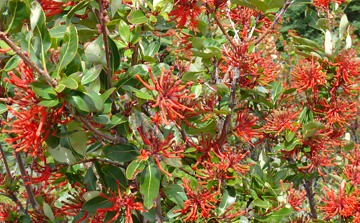Chilean firetree, Chilean firebush, Notro in Spanish (Embothrium coccineum), is a small evergreen tree in the family Proteaceae. It grows in the temperate forests of Chile and Argentina.
It produces deep red flowers (occasionally pale yellow) which group in clusters; blooming occurs in spring. The fruit is a dry follicle, with about 10 seeds inside.
It grows 4–15 m (13–50 ft) tall and can reach 50 cm (20 in) in diameter. The bark is dark grey with light spots. Its wood is light pink color, and besides for being very soft but durable, is used for elaborating spoons, kitchen vessels and another craft articles.
It is grown as an ornamental in Great Britain and the United States, and as far north as Faroe Islands at 62º North latitude.
The plant was introduced to Europe by William Lobb during his plant collecting expedition to the Valdivian temperate rain forests in 1845–1848. It was described by Kew Gardens as:
“Perhaps no tree cultivated in the open air in the British Isles gives so striking and brilliant a display as this does.”[1]
Embothrium coccineum is grown as an ornamental plant for its vivid red flowers. It is only successful in oceanic climates, which away from its native area includes western Europe (mainly the British Isles and the Faroe Islands), the coast of the Pacific Northwest of North America, and New Zealand. Embothrium does not tolerate the element phosphorus[citation needed] (when fertilizing, use a fertilizer with a middle number of 0, such as 15-0-5).
Together with Telopea, Oreocallis and Alloxylon, Embothrium makes up a small group of terminal often red-flowering showy plants scattered around the southern edges of the Pacific Rim. Known as the Embothriinae, this is an ancient group with roots in the mid Cretaceous, when Australia, Antarctica and South America were linked by land.[2][3] Almost all these species have red terminal flowers, and hence the subtribe’s origin and floral appearance must predate the splitting of gondwana into Australia, Antarctica, and South America over 60 million years ago. The prominent position and striking colour of many species within the subtribe both in Australia and South America strongly suggest they are adapted to pollination by birds, and have been for over 60 million years.[4]
(From Wikipedia, 14 May 2011)
—





